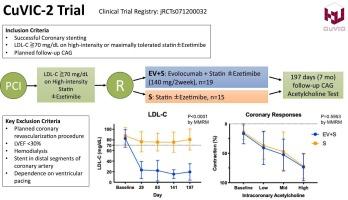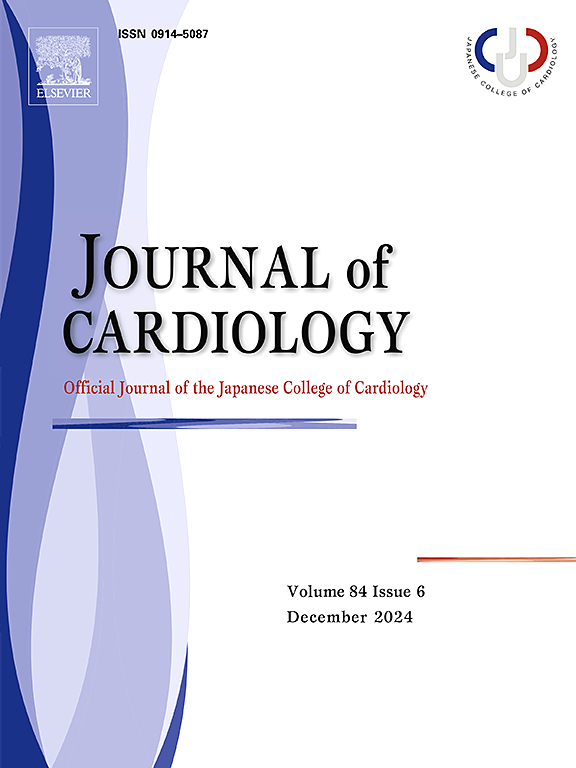PCSK9抑制剂对冠状动脉支架植入术后高胆固醇血症患者冠状动脉内皮功能障碍的影响:CuVIC-2试验
IF 2.6
3区 医学
Q2 CARDIAC & CARDIOVASCULAR SYSTEMS
引用次数: 0
摘要
背景:evolocumab对冠状动脉内皮功能障碍(CED)(动脉粥样硬化的标志)的影响尚不清楚。本研究的目的是研究evolocumab联合大剂量他汀类药物是否可以改善接受冠状动脉支架植入术患者的CED。方法:CuVIC-2试验为多中心随机对照试验。CED被定义为冠状动脉内乙酰胆碱(ACh)诱导的收缩反应,伴有心肌缺血的迹象。我们最初打算招募160名参与者,但由于COVID-19大流行改变了研究设计,然后招募了41名参与者。修订后的主要终点是在核心实验室评估的ACh反应的冠状动脉收缩率,确保使用重复测量的混合模型的统计能力超过80 %。结果:evolocumab联合高剂量他汀类药物(EV + S)组包括男性19例,女性4例,年龄62 ± 13 岁。大剂量他汀类药物加或不加依折替贝(S)组男性13名,女性5名,年龄64岁 ± 11 岁。与S组相比,EV + S组在28 周时低密度脂蛋白胆固醇的下降幅度显著大于S组;83 ± 17日至20日 ± 16 mg / dL(-76 %从基线)EV + 集团和88 ± 16至81 ± 20 mg / dL(7 %从基线)S组(p 结论:改进的清洁能源evolocumab没有观察到在这个实验中与几个局限性。本文章由计算机程序翻译,如有差异,请以英文原文为准。

Effect of PCSK9 inhibitor usage on coronary endothelial dysfunction in patients with hypercholesterolemia after coronary stenting: The CuVIC-2 trial
Background
The effects of evolocumab on coronary endothelial dysfunction (CED), a hallmark of atherogenesis, are unknown. The aim of this study was to investigate whether evolocumab, in combination with high-dose statins, could ameliorate CED in patients who underwent coronary stenting.
Methods
The CuVIC-2 trial was a multicenter randomized controlled trial. CED was defined as intracoronary acetylcholine (ACh)-induced contractile responses with signs of myocardial ischemia. We originally intended to enroll 160 participants but altered the study design due to the COVID-19 pandemic and then recruited 41 participants. The revised primary endpoint was the coronary contraction rate in response to ACh assessed in a core laboratory, ensuring a statistical power of over 80 % using the mixed model for repeated measures.
Results
The evolocumab in combination with high-dose statins with or without ezetimibe (EV + S) group included 19 males and 4 females aged 62 ± 13 years. The high-dose statins with or without ezetimibe (S) group included 13 males and 5 females aged 64 ± 11 years. Compared with the S group, the EV + S group presented a significantly greater decrease in low-density lipoprotein cholesterol at 28 weeks; 83 ± 17 to 20 ± 16 mg/dL (−76 % from the baseline) in the EV + S group and 88 ± 16 to 81 ± 20 mg/dL (−7 % from the baseline) in the S group (p < 0.0001). At 28 weeks, there was no difference between the two groups in terms of the coronary artery constriction rate across all doses [mean difference: 4.8 % (95 % CI: −13.6 to 23.2); p = 0.6].
Conclusions
Amelioration of CED by evolocumab was not observed in this trial with several limitations.
求助全文
通过发布文献求助,成功后即可免费获取论文全文。
去求助
来源期刊

Journal of cardiology
CARDIAC & CARDIOVASCULAR SYSTEMS-
CiteScore
4.90
自引率
8.00%
发文量
202
审稿时长
29 days
期刊介绍:
The official journal of the Japanese College of Cardiology is an international, English language, peer-reviewed journal publishing the latest findings in cardiovascular medicine. Journal of Cardiology (JC) aims to publish the highest-quality material covering original basic and clinical research on all aspects of cardiovascular disease. Topics covered include ischemic heart disease, cardiomyopathy, valvular heart disease, vascular disease, hypertension, arrhythmia, congenital heart disease, pharmacological and non-pharmacological treatment, new diagnostic techniques, and cardiovascular imaging. JC also publishes a selection of review articles, clinical trials, short communications, and important messages and letters to the editor.
 求助内容:
求助内容: 应助结果提醒方式:
应助结果提醒方式:


